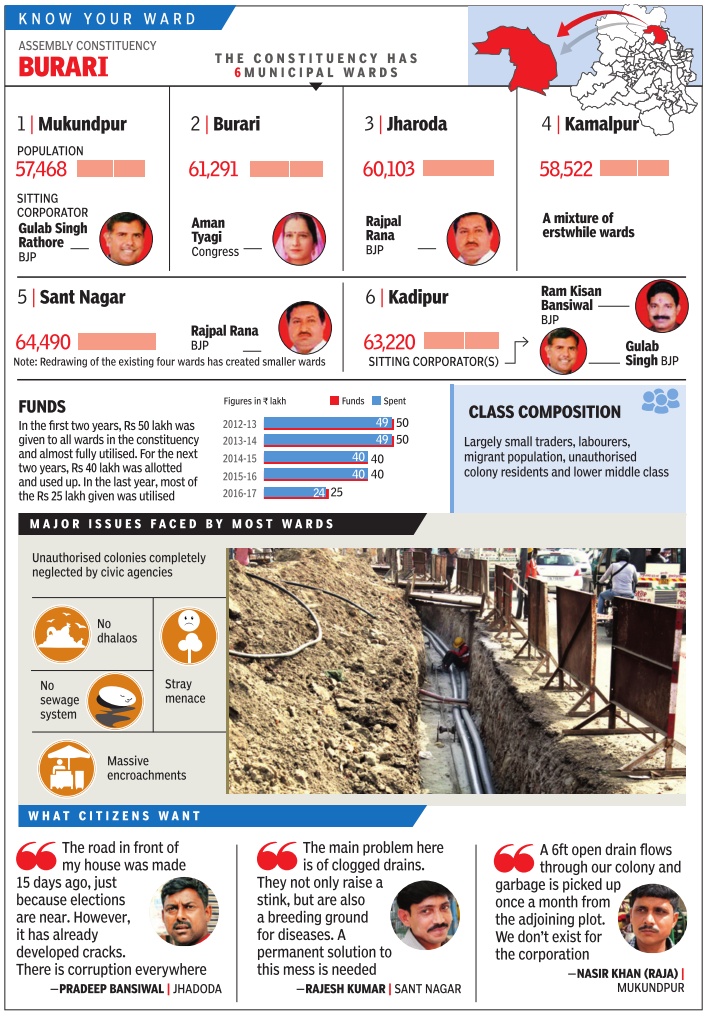Delhi: Burari
This is a collection of articles archived for the excellence of their content. |
Contents |
A constitutional profile
2020
Sidharatha Roy, January 21, 2020: The Times of India
House that! Legal tag to colonies matters, but access to basic necessities may weigh
Sidhartha.Roy@timesgroup.com
New Delhi:
Sanjeev Jha, is very accessible and tries his best to solve our problems,” Das testified.
Himgiri Enclave is among the ‘better’ of the constituency’s unauthorised colonies. Burari is one of the bigger assembly constituencies not only in terms of area, but also the electorate. With 3.5 lakh voters, it is third largest constituency in Delhi. It has quite a few villages such as Burari, Mukandpur, Mukhmelpur and Jagatpur. While some areas are still agricultural, much of the farm lands have been urbanised or taken over by authorised colonies. Some like Himgiri Enclave and Harit Vihar have wide roads and kothis built on large plots, but the rest of the unauthorised colonies have poor drainage and sanitation and almost non-existent roads.
“The road is being constructed,” said Awadesh Kumar, 50, a resident of Samta Vihar, pointing to the sludgy, undulating lane. “The area might look shabby, but it was much worse five years ago. A lot of development has taken place, including laying of sewer lines,” said Kumar, who hails from Uttar Pradesh but has been living in Burari for two decades.
Sewage still overflows on to the lanes in Sant Nagar on Burari Road. The area is a hub of coaching institutes and offers students accommodation at low rates.
So while regularisation of the unauthorised colony is cheering the people at election time, the ambiguities still bother them. Harit Vihar resident Ram Lakhan Vishwakarma confessed to being unsure of banks extending loans because his colony is still categorised as agricultural land in revenue records.
The Burari constituency has a mix of people from different communities, most of them migrants. While BJP’s Shri Krishan won the seat in 2008, AAP’s Sanjeev Jha was victorious in both the 2013 and 2015.
“There were huge farms here earlier, but this place is no longer a village. Agricultural land has given way to colonies and people from Uttar Pradesh, Haryana and Bihar are now in a majority,” said Karn Singh, 62, in Mukandpur Village.
According to Yashoda Kumari, 29, a resident of Janta Vihar, another unauthorised colony, road construction had started in her area.
Civic issues
2017
Paras Singh, A Poorvanchali pocket no party can take lightly, March 28, 2017: The Times of India

Located between Yamuna Biodiversity Park and the Bhalswa lake, Burari consists of a few old villages surrounded by a number of unauthorised, sub-urban colonies carved out of agricultural land. These colonies are mostly occupied by migrant families from eastern UP and Bihar, which have settled in Delhi over the past two decades. Little wonder that Poorvanchalis in Burari, who constitute 80% of the total population in the assembly constituency , are a vote bank all political parties are vying for.
AAP will kick-start its civic poll campaign in this key constituency with chief minister Arvind Kejriwal's rally on March 3. BJP had organised a large gathering of all the state functionaries here last month.
Post delimitation, Burai bags six municipal wards --Kadipur, Kamalpur, Burari, Jharoda, Sant Nagar, Mukundpur--and becomes the assembly segment with the highest number of wards in the north corporation. Still, the area reeks of neglect as basic amenities are almost absent in this region, which is close to the UP border.
The fact that almost three quarters of this region comprise unauthorised colonies makes it ample clear as to why development has always taken a backseat in Burari.“MCD doesn't exist here,“ said 31-year-old Satender Jha, pointing towards a heap of garbage at the entry to Mukundapur. “Garbage, choked drains, encroached roads, stray dogs and cows. You name a problem and we have it.On top of it, we have to pay MCD employees to get works done. Elections do not mean anything for us; they are just a game of power.“ In the absence of dhalaos, all empty plots in this area have turned into small dumpyards. An open drain flows through Mukundpur and heads towards Sant Nagar and Jhadoda. Each ward in this constituency of over 3.8 lakh people has its own set of problems. “Since the colonies have come up haphazardly on agricultural land, no dhalaos have been constructed. That is why the drains are choked,“ said Mukundpur's councillor Gulab Singh Rathore.
While the state of sanitation in Burari Village is better than that of adjoining localities, villagers attribute it to their own work rather than any effort by the civic authorities. The village, a stronghold of Tyagis, has produced many MLAs and councillors. Sunil Tyagi, a farmer, said, “Despite having our own representatives, nothing much has changed on the ground. With two more councillors, the funds will increase now, but I am sure politicians will continue to pocket the money .“
In the adjoining Sant Nagar, overflowing drains have disfigured the roads built by DSIIDC. Using these stretches is fraught with health risks. Gulab Rathore, a local councillor, said, “MCD has a limited portion of area under its jurisdiction. The rest of the work is to be done by DSIIDC and without the cooperation from local AAP MLA Sanjeev Jha, our hands are tied.“